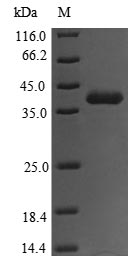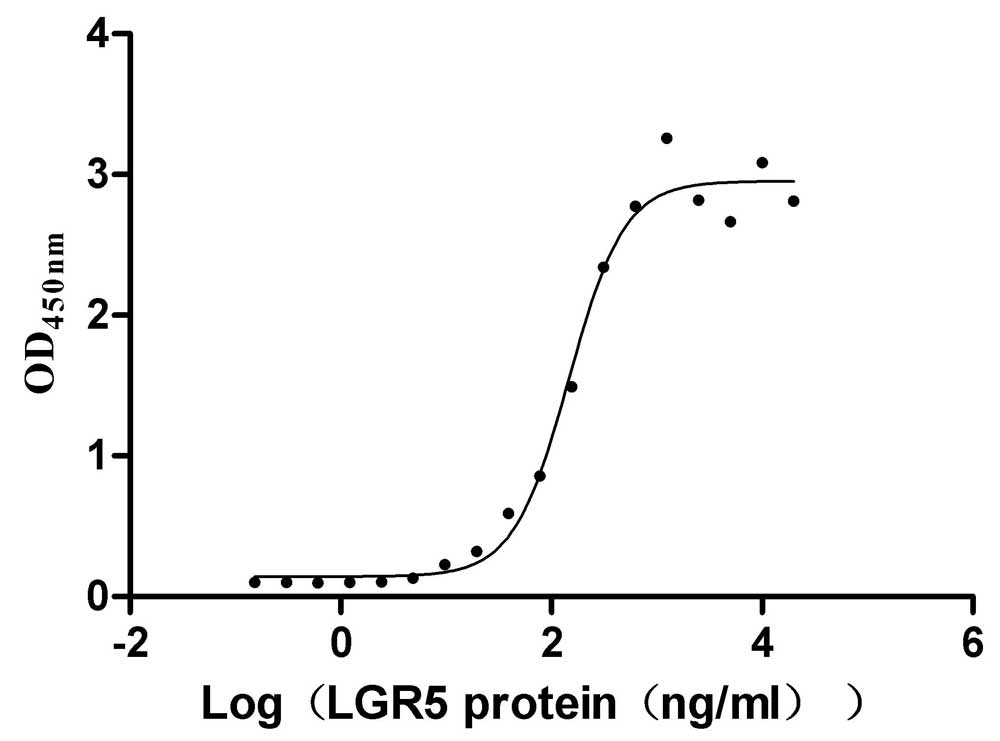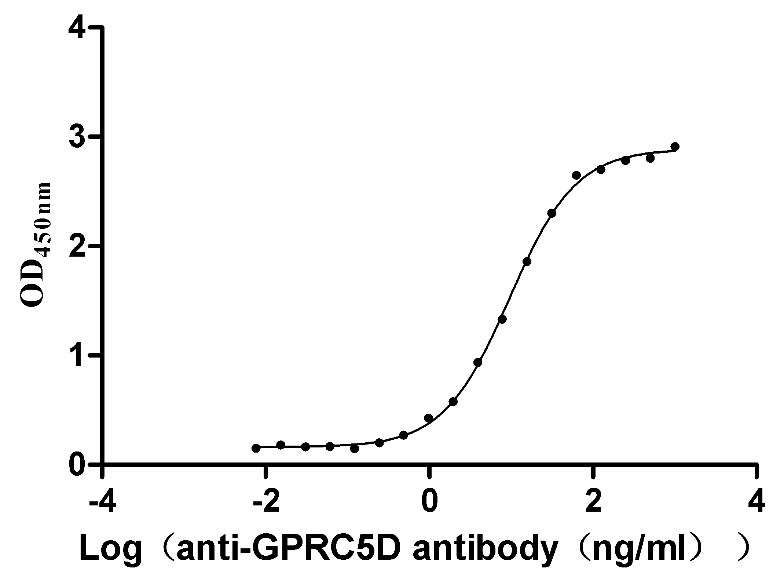Recombinant Clostridioides difficile Toxin A (toxA), partial
In Stock-
中文名称:Recombinant Clostridioides difficile Toxin A(toxA),partial
-
货号:CSB-EP324524DUN
-
规格:¥2328
-
图片:
-
其他:
产品详情
-
纯度:Greater than 85% as determined by SDS-PAGE.
-
基因名:toxA
-
Uniprot No.:
-
别名:toxA; tcdA; Toxin A; EC 3.4.22.-
-
种属:Clostridioides difficile (Peptoclostridium difficile)
-
蛋白长度:Partial
-
来源:E.coli
-
分子量:40.1 kDa
-
表达区域:2387-2710aa
-
氨基酸序列ASTGYTSINGKHFYFNTDGIMQIGVFKGPNGFEYFAPANTDANNIEGQAILYQNKFLTLNGKKYYFGSDSKAVTGLRTIDGKKYYFNTNTAVAVTGWQTINGKKYYFNTNTSIASTGYTIISGKHFYFNTDGIMQIGVFKGPDGFEYFAPANTDANNIEGQAIRYQNRFLYLHDNIYYFGNNSKAATGWVTIDGNRYYFEPNTAMGANGYKTIDNKNFYFRNGLPQIGVFKGSNGFEYFAPANTDANNIEGQAIRYQNRFLHLLGKIYYFGNNSKAVTGWQTINGKVYYFMPDTAMAAAGGLFEIDGVIYFFGVDGVKAPGIYG
Note: The complete sequence including tag sequence, target protein sequence and linker sequence could be provided upon request. -
蛋白标签:N-terminal 6xHis-tagged
-
产品提供形式:Liquid or Lyophilized powder
Note: We will preferentially ship the format that we have in stock, however, if you have any special requirement for the format, please remark your requirement when placing the order, we will prepare according to your demand. -
缓冲液:Tris-based buffer,50% glycerol
-
储存条件:Store at -20°C/-80°C upon receipt, aliquoting is necessary for mutiple use. Avoid repeated freeze-thaw cycles.
-
保质期:The shelf life is related to many factors, storage state, buffer ingredients, storage temperature and the stability of the protein itself.
Generally, the shelf life of liquid form is 6 months at -20°C/-80°C. The shelf life of lyophilized form is 12 months at -20°C/-80°C. -
货期:3-7 business days
-
注意事项:Repeated freezing and thawing is not recommended. Store working aliquots at 4°C for up to one week.
-
Datasheet & COA:Please contact us to get it.
相关产品
靶点详情
-
功能:Precursor of a cytotoxin that targets and disrupts the colonic epithelium, inducing the host inflammatory and innate immune responses and resulting in diarrhea and pseudomembranous colitis. TcdA and TcdB constitute the main toxins that mediate the pathology of C.difficile infection, an opportunistic pathogen that colonizes the colon when the normal gut microbiome is disrupted. Compared to TcdB, TcdA is less virulent and less important for inducing the host inflammatory and innate immune responses. This form constitutes the precursor of the toxin: it enters into host cells and mediates autoprocessing to release the active toxin (Glucosyltransferase TcdA) into the host cytosol. Targets colonic epithelia by binding to some receptor, and enters host cells via clathrin-mediated endocytosis. Binding to LDLR, as well as carbohydrates and sulfated glycosaminoglycans on host cells suface contribute to entry into cells. In contrast to TcdB, Frizzled receptors FZD1, FZD2 and FZD7 do not act as host receptors in the colonic epithelium for TcdA. Once entered into host cells, acidification in the endosome promotes the membrane insertion of the translocation region and formation of a pore, leading to translocation of the GT44 and peptidase C80 domains across the endosomal membrane. This activates the peptidase C80 domain and autocatalytic processing, releasing the N-terminal part (Glucosyltransferase TcdA), which constitutes the active part of the toxin, in the cytosol.; Active form of the toxin, which is released into the host cytosol following autoprocessing and inactivates small GTPases. Acts by mediating monoglucosylation of small GTPases of the Rho family (Rac1, RhoA, RhoB, RhoC, Rap2A and Cdc42) in host cells at the conserved threonine residue located in the switch I region ('Thr-37/35'), using UDP-alpha-D-glucose as the sugar donor. Monoglucosylation of host small GTPases completely prevents the recognition of the downstream effector, blocking the GTPases in their inactive form, leading to actin cytoskeleton disruption and cell death, resulting in the loss of colonic epithelial barrier function. Also able to catalyze monoglucosylation of some members of the Ras family (H-Ras/HRAS, K-Ras/KRAS and N-Ras/NRAS), but with much less efficiency than with Rho proteins, suggesting that it does not act on Ras proteins in vivo.
-
亚细胞定位:[Toxin A]: Secreted. Host endosome membrane.; [Glucosyltransferase TcdA]: Host cytoplasm, host cytosol. Host cell membrane; Peripheral membrane protein; Cytoplasmic side.
Most popular with customers
-
Recombinant Macaca mulatta Microtubule-associated protein tau (MAPT) (Active)
Express system: Mammalian cell
Species: Macaca mulatta (Rhesus macaque)
-
Recombinant Human R-spondin-1 (RSPO1), partial (Active)
Express system: Mammalian cell
Species: Homo sapiens (Human)
-
Recombinant Human G-protein coupled receptor family C group 5 member D (GPRC5D)-VLPs (Active)
Express system: Mammalian cell
Species: Homo sapiens (Human)
-
Recombinant Human Somatostatin receptor type 2 (SSTR2)-VLPs (Active)
Express system: Mammalian cell
Species: Homo sapiens (Human)
-
Recombinant Macaca fascicularis Claudin (CLDN18)-VLPs (Active)
Express system: Mammalian cell
Species: Macaca fascicularis (Crab-eating macaque) (Cynomolgus monkey)
-
Recombinant Human Claudin-4 (CLDN4)-VLPs (Active)
Express system: Mammalian cell
Species: Homo sapiens (Human)
-
Recombinant Human Claudin-6 (CLDN6)-VLPs, Fluorescent (Active)
Express system: Mammalian cell
Species: Homo sapiens (Human)
-
Recombinant Human Killer cell immunoglobulin-like receptor 3DL2 (KIR3DL2), partial (Active)
Express system: Mammalian cell
Species: Homo sapiens (Human)









f4-AC1.jpg)











